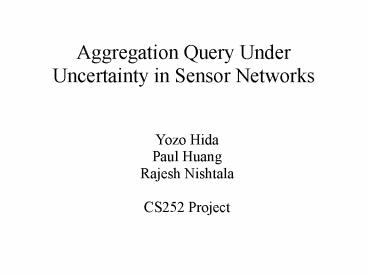Aggregation Query Under Uncertainty in Sensor Networks - PowerPoint PPT Presentation
1 / 31
Title:
Aggregation Query Under Uncertainty in Sensor Networks
Description:
Aggregation inside network reduces power. Faulty sensor gives erroneous sensor values ... Solution: Aggregation under faulty motes using Outlier Detection ... – PowerPoint PPT presentation
Number of Views:110
Avg rating:3.0/5.0
Title: Aggregation Query Under Uncertainty in Sensor Networks
1
Aggregation Query Under Uncertainty in Sensor
Networks
Yozo Hida Paul Huang Rajesh Nishtala CS252
Project
2
Outline
- Introduction, Motivation
- Design
- Outlier Detection
- Data Model
- Multipath Routing
- Data Collection
- Graphs
- Analysis
3
Introduction/Motivation
- One application in wireless sensor networks is
collecting sensor readings - Motes can be faulty and has power concerns
- Aggregation inside network reduces power
- Faulty sensor gives erroneous sensor values
- Motes lack of power can die
- Solution Aggregation under faulty motes using
Outlier Detection
4
Outlier Detection
- Use values of all data that can be heard
including local sensor value to maximize data set - Use previous values from all nodes to determine
whether test value is an outlier or not - If the value is determined to be valid, aggregate
it normally, otherwise throw it away
5
History Buffer
- Stores previous values of all nodes that can be
heard - Implemented with a FIFO queue of length 5
- Timeout mechanism implemented to remove stale
values
FIFO for child 1
6
History Buffer Test
- Compute mean and standard deviation over all
values in history buffer - If greater than 2.5 standard deviations or
greater than user defined standard deviations
then marked as invalid
7
Recent History /Neighbor Test
- Compute mean and standard deviation over latest
value in history buffer for all children - Implemented to give recent values higher weight
in the detection - If greater than 2.5 standard deviations or
greater than user defined standard deviations
then marked as invalid - If pass both tests add values into buffers
8
Local vs. Aggregate value
- Two different values returned in QueryResult
- Local Value (untrusted)
- Childs own sensor reading
- Checked before it is merged
- Aggregate Value (trusted)
- Childs aggregate value
- Assumed to be correct and allowed to be merged
9
Local vs. Aggregate Value (example)
Valid High Sensor Reading
Invalid High Sensor Reading
10
Flow of Events
- Get test value (either local sensor reading or
neighbors reading) - Run the test value through the History Buffer
Test - Run the test value through the Recent History
Test - If value passes both install value in History
Buffer otherwise throw value away
11
Node Placement and Sensor Values
- Sensor nodes are given coordinates in -1, 1 x
-1, 1. - Sensors can hear each other when they are within
certain distance of each other. - Simulator will supply sensor readings f(x, y, t)
at each node based on location and time. - Three placements we have tested rectangular
grid, hexagonal grid, and quasi-random locations
(rectangular grid used for detailed analysis). - Some sensor will start will reporting faulty
values after certain time.
12
Sensor Node Placement Grid
13
Sensor Node Placement Random
14
Sensor Value Function 1
15
Sensor Value Function 2
16
Multipath Routing
17
Multipath Routing
18
Multipath Routing
19
Multipath Routing
20
Multipath Routing
21
Multipath Routing
- Assumptions
- Mote density is high enough to reselect parent
- No Malicious Motes
- Parameters
- Parent_Reselect_Interval
- Epochs to wait before reselect
- Parent_Lost_Interval
- Duration to wait when not hearing from parent
- Reselect parent often to react faster under faults
22
Results
- Testcases
- of Failed Nodes (sensor reading error)
- Size of Outlier
- Node Density
- MAX, AVG
- Smooth vs Discontinuous Functions
- Default Values
- 10 Failed, 1500 vs 500, 81 Motes, MAX, Smooth
function
23
MAX on 81 nodes.
24
AVG on 81 nodes.
25
Varying Percentage of Failed Motes
26
Varying Outlier Size
27
Varying Node Density
28
Analysis
- Results remain stable for high percentage of
failed nodes (up to 95 faulty nodes) - Drawbacks
- Does not work when erroneous sensor readings
present at the start of the run - Does not protect sensor values against malicious
motes
29
Future Work
- Better Outlier Detection
- Large Sphere of Influence
- Use of temporal / spatial derivatives to analyze
the trends in data. - User Interface
- User settable threshold parameters
- Report outliers back to the user.
30
Experiences
- Nido Simulator
- Quite unstable and under development.
- Packet transimission does not always get through.
- TinyDB code
- Could only handle all-connected-to-all radio
model (fixed). - Timing issues (sometimes hangs).
31
Demo































